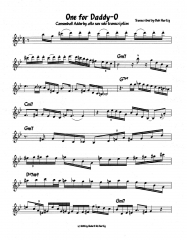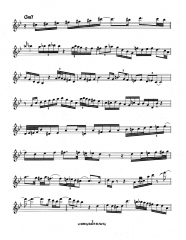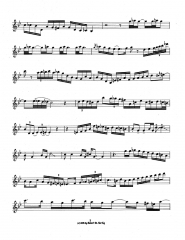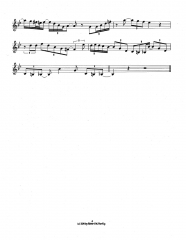If you’re an alto saxophonist, at some point you’re going to have to go through Cannonball Adderley just as surely as you’ve got to deal with Charlie Parker. Cannon’s buttery tone, prodigious technique, and ability to consistently and flawlessly deliver solos of pristine inventiveness make him a foundation stone of jazz saxophone.
The transcription on this page showcases Cannon playing on “One for Daddy-O,” a Bb minor blues with a head written by his brother, trumpeter Nat Adderley. The feel is a cool, casual shuffle, with no one in any hurry to get
anywhere. Even as Cannon cooks with passion and dexterity for four bars in double-time, he somehow manages to convey a laid-back mood that makes it sound as if he’s lying in a hammock and will return to sipping his iced tea as soon as he’s finished.“One for Daddy-O” is one of the tunes in the classic Adderley quintet album Something Else. When you give the CD a listen, check out the call-and-response between horns and piano in the head. Points of interest in Cannon’s solo include:
• Use of the G and D Phrygian dominant scales (mode five of the harmonic minor scale)–ex. bar 6, or the fourth bar into the first full 12-bar form; and bars 28 and 36, or the second and tenth bars of the third chorus.
• Rhythmic variety within an overall 16th-note double-time framework. There are places in this solo where you can hear Cannonball stretching the time like taffy, now speeding up, now slowing down, yet never failing to convey a sense of the underlying pulse. The only thing Cannon doesn’t do with time is lose it, even for an instant. It has been a challenge for me to try to capture in notation what he’s doing in some spots!
• Recurrent ideas–motifs, if you wish–that help to unify the solo. The walkdown to low Bb in bar 4 is a good example; you’ll find variations of it reiterated throughout the solo.
But enough of me talking. Time to get on to the solo. Click on the images on this page to enlarge them. And if you’d like to view more solo transcriptions as well as articles, video tutorials, and technical exercises, you’ll find them here.
I should add that I’m still not certain I’ve properly captured the rhythm of the very last two or three bars where Cannon winds things up. If it’s not spot-on, it’s close, and further listening will tell me whether I need to tweak that section or leave it be. Either way, I’ll remove this last paragraph once that final snippet is taken care of. Everything else checks out. Have fun with it!





